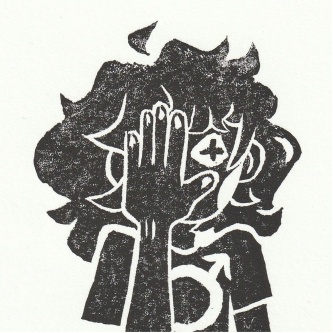The first thing they will remember is the burrowing.
Pulling themselves as small larvae, white specks in vast brown and green, deep within wet soil, egg-eyes still not accustomed to the thick silt, they will form intricate tunnels, hair-thin cities expanding infinitely below, in parallel.
This will be done both slowly and quickly – over days and also over 17,000 years. They will burrow and re-burrow, dig and re-dig, hear footsteps above and crawling beside and be wary of the digging through, of the point when soft digging becomes harsh excavation.
This will be the second thing they remember.
They will watch and move in careful step as muddy liquid stone is erected in verticality, cementing downward and reaching, with rigid steel fingers, towards both the watery earth and the infinite sky. They will listen as their siblings climb, live inside and with and under and on top of and outside. Their eyes will now see through not just the thinning dirt but the charged and parasitic dampness that encompasses it, emanates from the new city, the reaching-stone city on top of the circular dirt one. Revealed to them will be a twisting grid, steel and ground-up earthy fill in four or five dimensions, a new landscape on which to likewise expand their own agricultural inclinations.
And they will do this quickly; they will join their siblings in walls and floorboards and towering pillars, so sudden and silent and in such multitudes that these constructors of new landscapes will be unable to stop them, unable to notice, too centralized on their own internality. But their kin will notice, their cousins and not-cousins and those who would devour their soft bellies if they were still small. They will come and take refuge as well, feed from their palms and from the soft things that line hard walls. They will build new cities on top, through, underneath, they will come to know the corners of dampened asphalt more intimately than those who poured its hearty base. The builders will, at some point, take heed, spray down harsh repellent, but it will do no good; in response they will evolve more quickly, with more nuance, able to permeate that which builders saw impermeable.
And all this will be done from within, without exit, while still wholly juvenile. All this philosophizing and labour, accompanied with all this eating and looking and reaching and waiting. Waiting until they are ready. And then, after millennia of gestation, they will be. They will be born.
Shiny Dermestidae, dark and large as Great Danes, will burst from cracking, swelling concrete, backs painted in scattered ombre. They will begin to feed, wholly unrestrained, and yes, this will be the third thing they remember. But they will not feed like the humans feed; they will not be selfish and gluttonous. They will feed to replenish, to reconstruct, to lay bare. They will feed on the dust and the festered filling, the water-logged baseboards, the wall-to-wall rugs and the shiny mass-produced desks. They will eat the chequebooks and the phone lines, devour wires and files, lay the sticky eggs of their young across the stacks of bills that decorate the vaults. They will pick at the fleshy exterior and the rotting organs of the architectural body, the city-body, the concrete body, and chew it down to the bone.
They will not, however, work off human logics, at human whim. Yes, they will nibble at flaking paint, find buffets at landfills, but they will likewise gnaw through freshly laid marble, merino wool rugs. The personal dwelling is neither targeted nor exempt. They will eat at whatever may suppress, whatever barrier stands in the way of equitable urban liberation.
Or perhaps they will just eat.
And, after all this, when the noises of the city are quieted, new tunnels dug through its center, new rivers erupting at its base, new life climbing gloriously amongst its uncovered network of shimmering steel and porous concrete, they will then return to the earth to die. They will return to the city-dirt, to the gaping holes of torn cement, to the places their children will pull themselves to once they hatch, where they too will watch and listen and work for 17,000 years. They will go back and dig deeply, pull dirt over heavy eyes, and this burrowing will be, again, the last thing they remember.
**
A Brief Afterword
In writing and thinking with relationality I was also led to think of how we (as idealized human creatures) create zones of un-relation, of alienation. To quote Stacy Alaimo, “the pervasive trope of the oceans as alien may alienate humans from the seas, but it may also suggest that sea life hovers at the very limits of what terrestrial humans can comprehend” (Alaimo 477). I would suggest an extension of this sense of alienation to the insect, a sense that is in fact deepened by our intimate proximity, our obfuscated co-habitation.
I would additionally like to introduce a term to describe these intra-actions; as DeWolff describes the Plastisphere as a “growing realm . . . where sea life and plastic meet” (De Wolff 23), I would like to define this urbanized nature-culture as a Concretisphere, or the space in which terrestrial life (and specifically insects) thrive and adapt with the confines of concretized city spaces.[1]
[1] Her plastic milk crate is my steel-boned skyscraper

Richie Evans
Richie Evans (he/they) is an artist based in Tkaronto whose practice revolves around creative writing and the visual arts, focusing on exploring themes of queerness, disability, and political resistance through poetry, printmaking, and various forms of multimedia experimentation.
Alaimo, Stacy. “States of Suspension: Trans-Corporeality at Sea.” Interdisciplinary Studies in Literature and Environment, vol. 19, no. 3, 2012, pp. 476–93.
De Wolff, Kim. “Plastic Naturecultures: Multispecies Ethnography and the Dangers of Separating Living from Nonliving Bodies.” Body & Society, vol. 23, no. 3, 2017, pp. 23–47.
